

Luther
Reinforcement and punishment can modify your child's behaviour. The difference between them is that reinforcement aims to increase target behaviour while punishment aims to decrease behaviour.
Operant conditioning: Positive-and-negative reinforcement and punishment. Operant conditioning. The Use of Reinforcement and Punishment in Shaping a Child's Behavior. Positive & negative punishment graphic. Using negative punishment. Negative punishment is a popular concept in parenting.
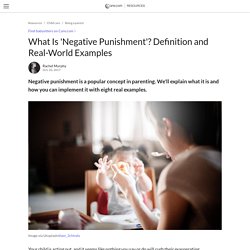
We'll explain what it is and how you can implement it with eight real examples. Your child is acting out, and it seems like nothing you say or do will curb their exasperating behavior. Sound familiar? Using Negative Punishment. Negative punishment is an important concept in B.
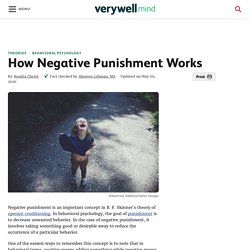
F. Skinner's theory of operant conditioning. In behavioral psychology, the goal of punishment is to decrease unwanted behavior. Using Positive Punishment. Is positive punishment effective? Positive punishment!

Sounds like a perfect oxymoron. But how can a punishment be positive? How can you even enforce such a punishment? Is it effective? Before many such questions crop in your mind, let us explain what we are going to tell you in this post. Should parents use timeout (Positive punishment) Positive reinforcement more effective than negative reinforcement to address problematic behaviour. Positive vs. Negative Reinforcement: A Guide for Parents. I almost stopped bringing them to the playground.
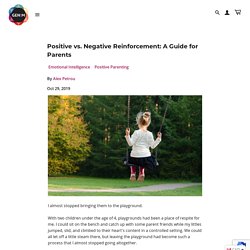
With two children under the age of 4, playgrounds had been a place of respite for me. I could sit on the bench and catch up with some parent friends while my littles jumped, slid, and climbed to their heart's content in a controlled setting. We could all let off a little steam there, but leaving the playground had become such a process that I almost stopped going altogether. Inevitably, when I announced it was time to go, my 3-year-old would run away. Laughing maniacally, he’d climb a slide or shimmy to the top of a play structure and gleefully gaze down at me as though it was a joke, as though dinner didn’t need to be made and naps didn’t need to happen.
Meanwhile my 2-year-old would cry. Executing a graceful playground exit is apparently one of the finer arts of parenting, and clearly one I hadn’t mastered. None of those felt quite right. Positive Reinforcement Versus Negative Reinforcement. Parents are responsible for the well-being of their children on a variety of levels.
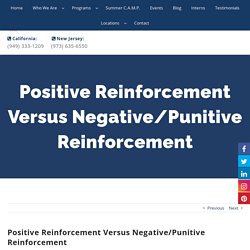
This includes teaching them how to properly observe rules that keep them safe, support strong communities, and help them grow into productive adults who can work with others to achieve common goals. When a child misbehaves or chooses to ignore these rules, parents need to institute punitive measures to correct the behavior.
There is an endless list of parenting philosophies that claim to show parents how to discipline their children in the most effective way. Methods range from emotional coaching techniques that encourage children to recognize and logically analyze their feelings to old-fashioned corporeal punishments like spankings. In 2012, the Brookings Institute found that over 70% of American households believed that spankings were a necessary way to correct unwanted behaviors in children. Today, many parents are turning away from the old styles of disciplining their children.
Positive attention. Using positive reinforcement. Children don’t come with instructions and discipline is often experienced by parents and children alike as an arena where our will and wits are tested.

Using positive reinforcement. If you read our earlier piece on positive punishment, you know that there are different methods of teaching and instilling good habits and behaviors.
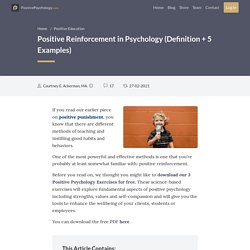
One of the most powerful and effective methods is one that you’re probably at least somewhat familiar with: positive reinforcement. Before you read on, we thought you might like to download our 3 Positive Psychology Exercises for free. These science-based exercises will explore fundamental aspects of positive psychology including strengths, values and self-compassion and will give you the tools to enhance the wellbeing of your clients, students or employees. You can download the free PDF here. Positive reinforcement more effective than negative reinforcement. Children can get themselves into all kinds of mischief.

Taking stuff that doesn’t belong to them, lying, doing things that they know they shouldn’t do, sucker-punching their little brother — it’s a long list. Then there is the even longer list of forgetting to do things that they’re supposed to do. Using positive reinforcement schedule. When your child misbehaves, rewards might be the last thing on your mind.
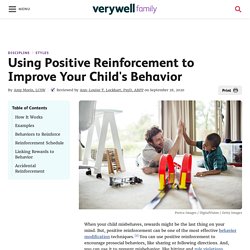
But, positive reinforcement can be one of the most effective behavior modification techniques.1 You can use positive reinforcement to encourage prosocial behaviors, like sharing or following directions. And, you can use it to prevent misbehavior, like hitting and rule violations. Positive reinforcement can also be an effective way to encourage and motivate your child to be responsible, do their chores, get along with their siblings, or complete their homework assignments without arguing. Schedules of Reinforcement. Schedules of Reinforcement By Annabelle G.Y.

Lim , published July 02, 2020 Key Takeaways: Reinforcement Schedules A reinforcement schedule is a rule stating which instances of behavior, if any, will be reinforced.Reinforcement schedules can be divided into two broad categories: continuous schedules and partial schedules (also called intermittent schedules).In a continuous schedule every instance of a desired behavior is reinforced, whereas partial schedules only reinforce the desired behavior occasionally.Partial reinforcement schedules are described as either fixed or variable, and as either interval or ratio.Combinations of these four descriptors yield four kinds of partial reinforcement schedules: fixed-ratio, fixed-interval, variable-ratio and variable-interval.
In 1957, a revolutionary book for the field of behavioral science was published: Schedules of Reinforcement by C.B. Introduction Introduction. Rewarding behaviour is key to parenting teens, study suggests. Parenting is hard, and parenting teens brings about an entirely new set of challenges, from keeping their rooms clean to getting them home before curfew.
But, a new study suggests parents who want their teenagers to keep their grades up could have better success if they focus more on rewarding good behavior and less on threatening to punish the bad. According to the report, published in PLOS Computational Biology, British researchers have found that adolescents focus well on positive incentives, but have difficulty staying motivated to avoid penalties. The study shows that teens and adults learn in different ways, according to the study’s lead author Stefano Palminteri, a researcher with the Institute of Cognitive Neuroscience at University College London.
It suggests that “in some cases positive feedback may have more of an effect than negative feedback on learning” in adolescents. “Rewards give them something they want to think about,” Allen said. Punishing a child is effective if done correctly: Some children need consequences to succeed. While recently published parenting books have preached the effectiveness of positive parenting and "no drama" discipline, psychologists presenting at the American Psychological Association's 123rd Annual Convention said don't put timeout in timeout yet. "Parental discipline and positive parenting techniques are often polarized in popular parenting resources and in parenting research conclusions," presenter and researcher Robert Larzelere, PhD, of Oklahoma State University, said at a symposium.
"But scientifically supported parenting interventions for young defiant children have found that timeouts and other types of assertive tactics can work if they're administered correctly. " In his presentation, Larzelere said his research team interviewed 102 mothers who provided detailed descriptions of five times they had to discipline their toddlers for hitting, whining, defiance, negotiating or not listening. Longer-term effects revealed a different pattern.